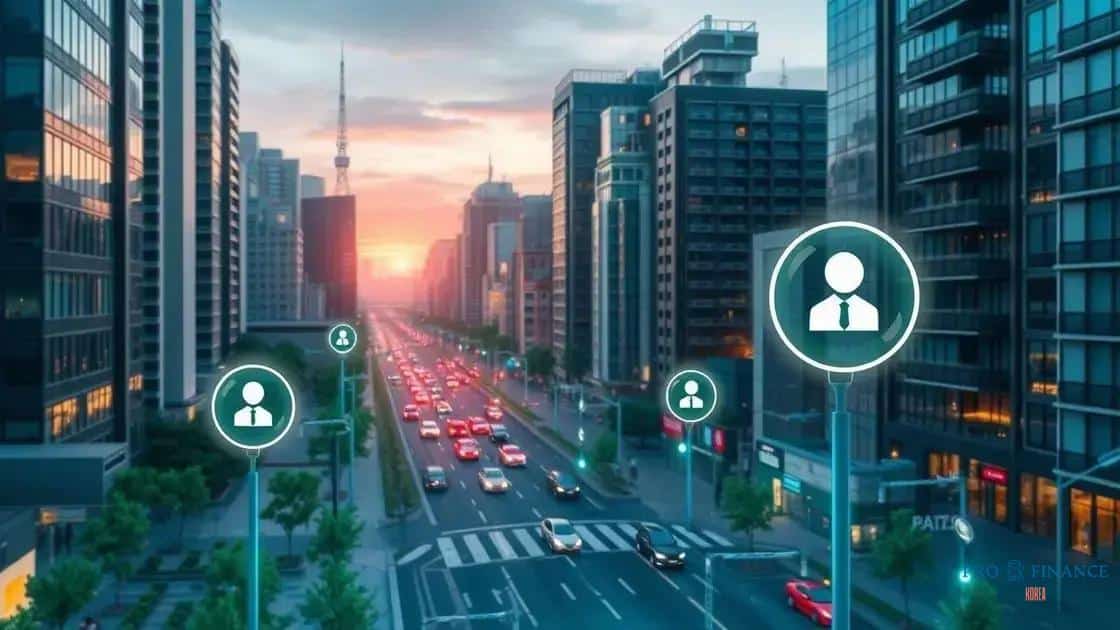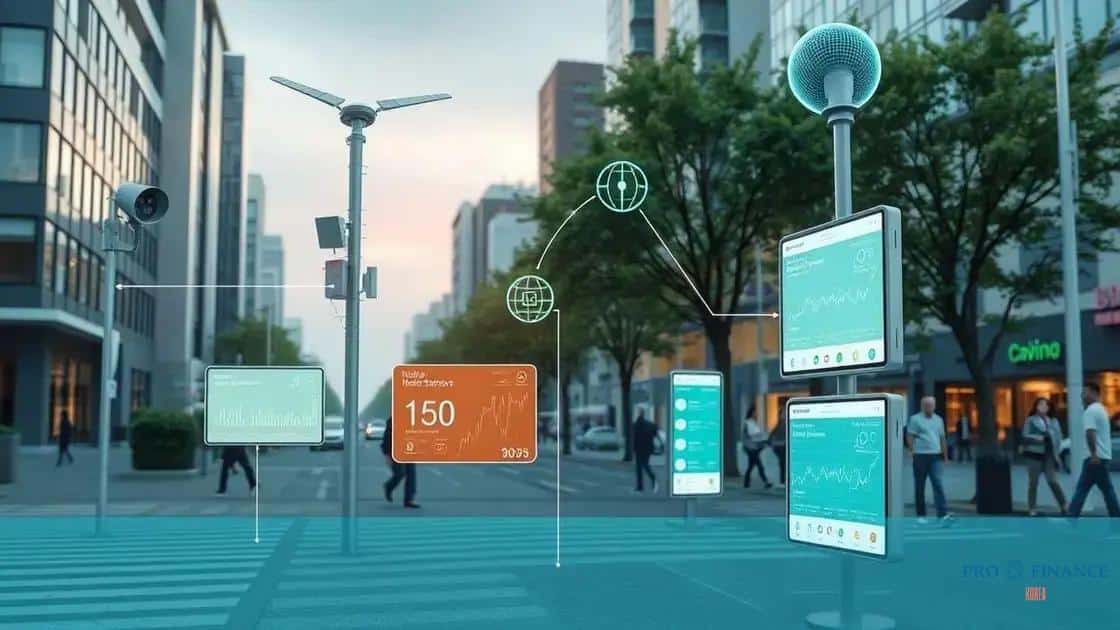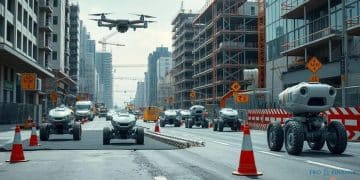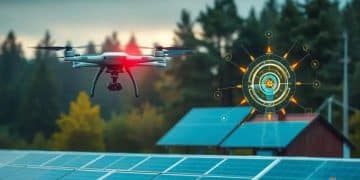How smart cities are using IoT for environmental monitoring

Smart cities are leveraging IoT technology for environmental monitoring to improve data collection, enhance public health, and engage communities, fostering sustainability and resilience in urban environments.
How smart cities are using IoT for environmental monitoring is a fascinating topic that blends technology with sustainability. Have you ever wondered how urban areas leverage data to improve our quality of life? In this article, we’re diving deep into the ways IoT helps cities flourish.
The role of IoT in city planning
The Internet of Things (IoT) is playing a pivotal role in modern city planning. With the constant growth of urban areas, integrating technology into city management is crucial. IoT enables cities to collect and analyze data, which helps in making informed decisions.
Through sensors and connected devices, cities can monitor various aspects such as traffic flow, energy usage, and even air quality. This information is invaluable for planners and government officials, allowing them to create more sustainable and efficient urban environments.
Enhancing Urban Infrastructure
IoT devices are transforming how urban infrastructure is developed and maintained. Smart traffic lights adjust in real-time based on vehicle flow, optimizing traffic patterns and reducing congestion. Moreover, smart waste management systems use sensors to monitor waste levels, making collection routes more efficient.
- Improved traffic management through real-time data.
- Energy-efficient buildings with smart utilities.
- Effective waste collection systems based on need.
Furthermore, IoT technology facilitates better public safety. Surveillance cameras and environmental sensors can alert authorities to unusual activity or hazardous conditions, leading to quicker responses. This instant communication between devices creates a safer living environment for residents.
Citizen Engagement through Data
City planners are also leveraging IoT data to engage citizens. By providing real-time updates on road conditions, public transport schedules, and community events, cities foster a sense of community and keep residents informed. This access to information empowers citizens to participate actively in their cities’ planning and development.
As IoT continues to evolve, its integration into city planning will also advance. Future cities will likely be closely interconnected through various platforms, enhancing livability and sustainability.
In summary, IoT’s impact on city planning is profound. By enhancing infrastructure, improving safety, and engaging citizens, smart cities are reshaping how urban environments operate, leading to a better quality of life for all.
Benefits of real-time environmental data

Real-time environmental data offers a host of benefits for smart cities and their residents. This immediate access to information allows city planners and agencies to act swiftly in addressing environmental concerns. Monitoring factors such as air quality, noise levels, and temperature can significantly enhance urban living.
One of the most significant advantages is the ability to respond to pollution levels effectively. For example, when sensors detect high levels of air pollution, authorities can quickly implement measures to reduce emissions. This can include adjusting traffic flow or temporarily banning certain vehicles from specific areas.
Improving Public Health
Real-time data enhances public health initiatives as well. Understanding the current state of the environment allows officials to provide timely alerts to residents. For instance, if air quality drops, citizens can be informed to stay indoors, particularly those with respiratory issues. Access to this data empowers individuals to make informed decisions regarding their health.
- Quicker responses to environmental hazards.
- Increased awareness of health risks associated with pollution.
- Empowerment of citizens to protect themselves.
Moreover, with continuous environmental monitoring, cities can identify trends and patterns. This long-term data collection helps in predicting future environmental changes and challenges. It enables urban planners to create sustainable solutions that can adapt to potential problems before they escalate.
Enhancing Urban Livability
Real-time data also contributes to overall urban livability. By understanding noise levels, planners can implement strategies to reduce sound pollution. Parks and green spaces can be designed to mitigate these impacts, improving the quality of life for all residents.
Additionally, data from weather sensors can help in managing energy use in buildings. During extreme weather conditions, real-time insights allow for better optimization of heating and cooling systems, ultimately saving energy and reducing costs.
The integration of real-time environmental data into city operations not only creates a more responsive government but also fosters a culture of sustainability among citizens. With greater visibility into environmental metrics, communities are encouraged to participate in green initiatives, further promoting a healthy urban ecosystem.
Challenges faced in IoT implementation
Implementing the Internet of Things (IoT) in smart cities faces several significant challenges. While the potential benefits are numerous, the journey to effective IoT integration can be complex and fraught with obstacles.
One major challenge is the cost associated with deploying IoT devices and infrastructure. Investing in sensors, communication networks, and data processing systems can be a financial burden for city budgets. Additionally, maintaining these systems adds another layer of expense. Budget constraints often hinder the ability to fully implement IoT solutions.
Data Security and Privacy
Data security is also a critical concern. With the vast amount of information collected by IoT devices, cities face the risk of data breaches and cyberattacks. Ensuring that sensitive information about citizens remains protected is paramount. This requires robust cybersecurity measures, which can be complicated and costly to implement.
- Risk of data breaches and cyber threats.
- Need for continuous monitoring of security systems.
- Potential legal implications of data misuse.
Furthermore, installing multiple IoT devices can lead to interoperability challenges. Many devices come from different manufacturers and use various communication protocols. This lack of standardization can create compatibility issues, making it difficult for different systems to communicate seamlessly.
Public Awareness and Acceptance
Another hurdle is public awareness and acceptance of these technologies. Residents may be skeptical about the data collected by devices and how it is used. Building trust is essential for encouraging citizen participation in smart city initiatives. City officials must engage with the community to explain the benefits and address any concerns regarding privacy and data usage.
Lastly, the rapid evolution of technology presents its own challenges. Keeping up with the latest innovations requires continuous learning and adaptation. Cities must stay informed about emerging trends and technologies to make sure their IoT implementations do not become obsolete.
Despite these challenges, cities can find solutions through collaboration, strategic planning, and engaging stakeholders. Understanding the complexities of IoT implementation enables urban planners to navigate obstacles and work towards creating truly smart cities.
Case studies of successful smart cities

Examining case studies of successful smart cities reveals how innovative technologies can transform urban living. Around the world, cities are implementing IoT solutions to address various urban challenges effectively. These case studies serve as examples for other cities looking to adopt similar strategies.
One notable example is Barcelona, which has integrated IoT technology across various sectors. The city’s smart lighting system adjusts based on the presence of pedestrians, reducing energy use by 30%. Additionally, smart waste bins send alerts when they are full, streamlining waste collection.
Singapore’s Smart Nation Initiative
Another leading example is Singapore‘s Smart Nation initiative. This program incorporates IoT devices to monitor everything from traffic patterns to environmental conditions. By utilizing data analytics, Singapore can optimize transport routes and reduce congestion, greatly improving the flow of people and goods.
- Real-time traffic management to enhance commute efficiency.
- Environmental sensors to promote sustainability.
- Public spaces equipped with Wi-Fi to encourage connectivity.
Furthermore, in Amsterdam, the city uses IoT to engage its citizens in sustainability efforts. Smart meters track energy usage in real-time, encouraging residents to reduce their consumption. The city also incentivizes the use of electric vehicles with a network of charging stations that are integrated into the city’s infrastructure.
Reducing Carbon Footprint in Copenhagen
Another compelling case is Copenhagen, which aims to become the world’s first carbon-neutral capital by 2025. The city utilizes IoT to monitor energy usage in buildings and optimize public transportation routes. This initiative not only aids in lowering carbon emissions but also promotes the adoption of green energy solutions.
These examples illustrate the variety of ways cities can implement smart technologies to improve urban life. By learning from successful smart cities, other urban areas can develop tailored solutions to their unique challenges. Collaborative efforts between government, private companies, and citizens are essential for creating thriving smart ecosystems.
Future trends in IoT for environmental monitoring
As we look ahead, various future trends in IoT for environmental monitoring are emerging that promise to enhance how cities manage their ecosystems. With ongoing advancements in technology, cities will become smarter and more efficient in addressing environmental challenges.
One significant trend is the rise of artificial intelligence (AI) integration with IoT devices. AI can analyze vast amounts of data collected by sensors in real-time. This capability allows city officials to predict environmental changes and make proactive decisions. For example, AI algorithms can monitor air pollution levels and suggest measures to mitigate harmful emissions before they reach critical levels.
Expansion of Smart Sensor Networks
Another upcoming trend is the expansion of smart sensor networks. These sensors will be more affordable and easier to deploy than ever before. Cities will install tiny sensors across parks, roads, and buildings to gather detailed data on various environmental factors, such as temperature, humidity, and air quality. The widespread use of these sensors enables comprehensive monitoring.
- Real-time updates on environmental conditions.
- Improved accuracy in data collection.
- Enhanced public access to environmental data.
Moreover, the use of blockchain technology is likely to gain traction as well. By providing secure and transparent data management, blockchain can enhance trust in environmental data. This approach helps cities share data more efficiently with stakeholders, including residents and researchers, ensuring everyone has access to reliable information.
Citizen Engagement through Mobile Apps
Engaging citizens in environmental monitoring is another promising trend. Cities are increasingly launching mobile applications that allow residents to report environmental issues and receive real-time updates. These apps empower citizens to take action in their communities, fostering a sense of ownership of local environmental conditions.
Finally, the push for sustainability will drive the adoption of renewable energy sources coupled with IoT technology. Smart solar panels and wind turbines can monitor energy production and consumption, optimizing energy use in real-time. This integration leads to more sustainable urban environments, reducing cities’ overall carbon footprints.
FAQ – Frequently Asked Questions about IoT in Environmental Monitoring
What are the main benefits of using IoT for environmental monitoring?
IoT provides real-time data, enhances resource management, and improves public health by monitoring air quality and environmental conditions.
How does AI integrate with IoT in smart cities?
AI analyzes the vast data collected by IoT devices, allowing cities to make informed, proactive decisions to address environmental issues.
What challenges do cities face when implementing IoT?
Cities encounter challenges such as costs, data security concerns, interoperability of devices, and the need for public engagement.
How can citizens participate in environmental monitoring?
Cities are developing mobile apps that allow residents to report issues and access real-time data, encouraging active participation in community sustainability efforts.






